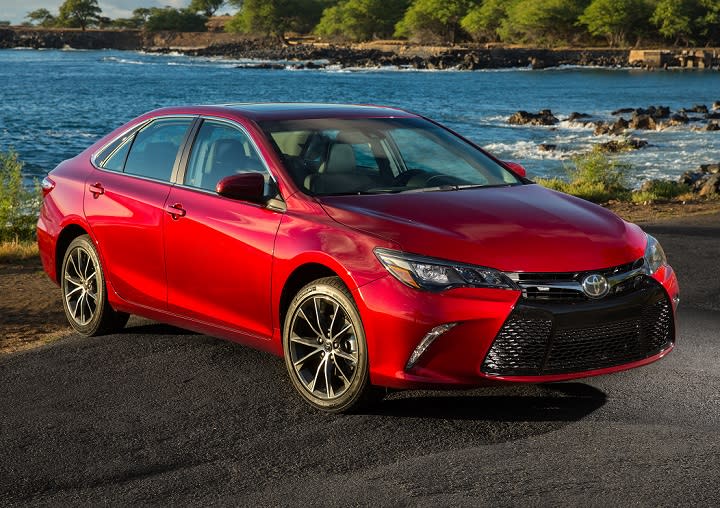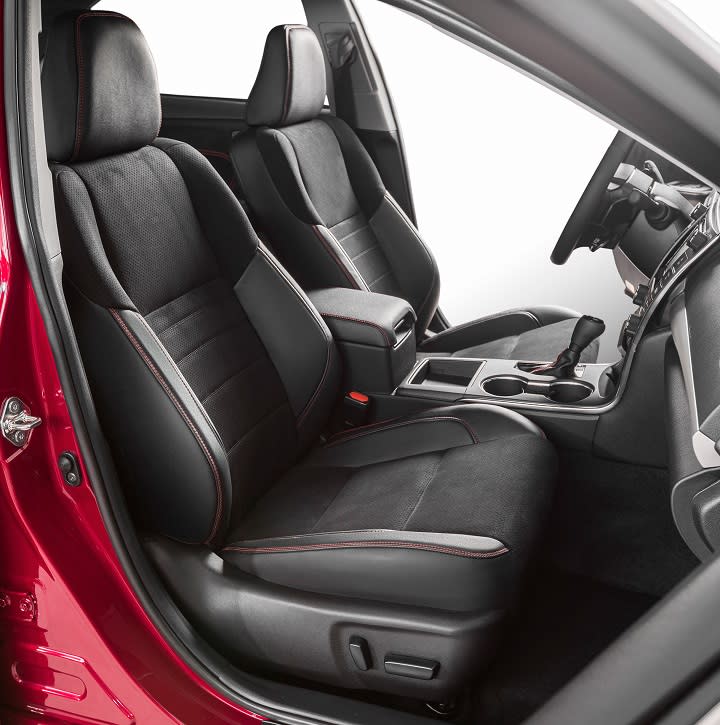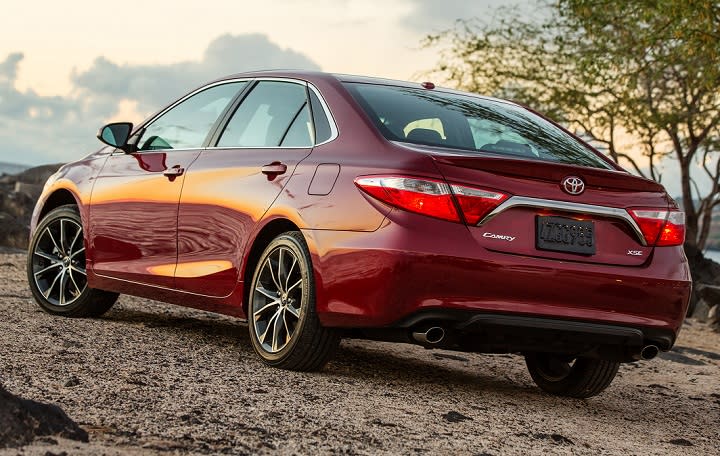PowerSteering: 2017 Toyota Camry Review
Introduction
Toyota is getting ready to launch a completely redesigned Camry, for the first time since the 2012 model year. And that means the company is eager to sell down inventory of the outgoing 2017 Toyota Camry. Bargains shall be had by people who remain interested in sedans instead of crossover SUVs, so we decided to take one last look at the old Camry before it rolls over the horizon into the sunset.
When you shop for a Camry, you have a few decisions to make. First, you need to decide if you want something sporty or not, which dictates whether you look at the LE and XLE trim levels, or the tautly-tuned SE and XSE trim levels. Next, pick a powertrain: 4-cylinder, V-6, or gas-electric hybrid. Then, add what few options are available, select a color, and you’re on your way home in a car that will last a good, long time.

For this review, we evaluated a 2017 Camry XSE with a 4-cylinder engine and an upgrade package containing floor mats, keyless entry with push-button engine starting, blind-spot warning system with rear cross-traffic alert, power sunroof, and a few other items. The sticker price came to $29,680, including the $885 destination charge.
What Owners Say
Before we discuss the results of our evaluation of the outgoing 2017 Camry, it’s helpful to understand who buys this midsize car and what they like most and least about it.
Demographically, Camry buyers aren’t much different from Midsize Car owners. More of them are women (42% vs. 39% segment average), their median age is 55 years (vs. 54 years), and their median household income is $374 higher at $87,250 (vs. $86,876). Gen Y (those born 1977 to 1994) isn’t as interested in the Camry (17% vs. 22%), perhaps because their Baby Boomer (1946-1964) parents are (46% vs. 43%).
Camry buyers are, naturally, less likely to agree that they prefer to buy from a domestic company (46% vs. 53% segment average). They are also more likely to strongly agree that they avoid vehicles with high maintenance costs (72% vs. 68%); that their first consideration in choosing a vehicle is quality of workmanship (57% vs. 50%); and that their first consideration in choosing a vehicle is reliability (74% vs. 66%).
Clearly, the Toyota Camry’s reputation precedes it.
Surprisingly, fewer Camry buyers are willing to pay extra for an environmentally friendly vehicle (52% vs. 56% segment average). Predictably, 64% of Camry buyers claim to like a vehicle that stands out from the crowd (vs. 71%), which helps to explain why 52% of Camry buyers view a vehicle as just a way to get from place to place (vs. 46%).
Buyers say their favorite things about the Camry are (in descending order) the engine/transmission, exterior styling, interior design, driving dynamics, and seats. Buyers indicate their least favorite things about the Camry are (in descending order) the storage and space, visibility and safety, infotainment system, climate control system, and fuel economy.
What Our Expert Says
In the sections that follow, our expert provides his own assessment of how the 2017 Toyota Camry performs in each of the 10 categories that comprise the J.D. Power 2016 U.S. Automotive Performance, Execution and Layout (APEAL) Study.SM
Exterior
Buyers rate the Camry’s styling as their second favorite thing about this family sedan, but I’m going to need to disagree. Especially in comparison with several of its direct competitors, this is not a visually appealing car from the outside.
When the current Camry came out for the 2012 model year, it was sharply creased for aerodynamic efficiency, but that styling approach transformed the car into an appliance. Toyota tried to rectify that with a refresh for 2016, re-skinning the old car with more dramatic sheetmetal. Still, the old Camry remains evident in the greenhouse and roofline, which date to 2012.
At best, I can say the sleeker look gives the Camry the appearance of a Lexus knock-off.
Interior
Featuring microfiber seat inserts, red accent stitching, and soft-touch dashboard materials, the XSE test car’s interior is about as nice as it gets...for a Camry. I’m also a fan of the instrumentation and the general control layout, because everything is easy to find and easy to use.

Still, this cabin is looking dated, in part because the materials on the lower portion of the interior are composed primarily of hard plastic that isn’t shy about revealing itself as much. Competitors offer comparatively modern and upscale cabins, and Toyota will no doubt rectify this situation with the upcoming 2018 model.
Seats
The Camry XSE supplies a good driving position, but after a few hours on the road, the seats feel hard more than they do supportive. The center console armrest padding is just dense enough to avoid criticism, while the leather wrapped around the steering wheel is not as supple and smooth as it should be. Notably, the simulated suede inserts help to hold the driver in place when operating the car with enthusiasm.
Equipped with a bottom cushion that sits high with good thigh support, the rear seat is reclined at too great an angle for my comfort. Plus, the leatherette trim located along the seams of the test car’s folding seatbacks rubbed and squeaked when people sat in the back. It is nice that there are air vents for rear passengers, and that they can be turned off, but Toyota offers no USB ports or electrical outlets.
Climate Control System
In my experience, the Camry XSE’s climate control system works well, and is super simple to use thanks to big knobs, large buttons, and plain markings. The control panel is not particularly flashy, but you don’t need to think much in order to operate them. Plus, I’ll bet you can adjust settings while wearing gloves.
Yet, Camry buyers say the climate system is their second least favorite thing about this car after disappointing fuel economy.
Infotainment System
Toyota is gradually rolling out next-generation versions of its Entune infotainment systems, and they’re not installed in the 2017 Camry. Nevertheless, I definitely appreciate the main menu buttons flanking the screen and the large radio knobs that make adjusting the stereo easy to do without looking away from the road.
Using the radio station pre-set buttons, which are the virtual touch-sensing variety stacked on the left side of the display screen, is not as simple, especially because they’re difficult to use with accuracy on imperfect pavement.
Also, if you’re looking for a car equipped with Apple CarPlay or Android Auto smartphone-projection technology, you can cross every Toyota off of your shopping list. The company doesn’t offer this feature. Siri Eyes Free compatibility is baked into every Camry, though, and wireless Qi-compatible charging is standard for the XLE and XSE.
Storage and Space
Inside, the Camry provides numerous locations in which owners can stash things. In addition to a sizable glove box and a big center console, there is a large bin forward of the cupholders and shifter, bins in the door armrests, narrow front door panel slots with bottle holders, and even a decent-sized sunglasses holder.
Back seat storage is not as generous, which is typical. Compartmentalized rear door bins and dual seatback map pockets amount to the solutions in the rear quarters.
The Camry’s trunk measures 15.4 cu. ft., putting it on the smaller side of the midsize sedan class.
Visibility and Safety
Personally, I have no trouble with regard to outward visibility from the Camry’s driver’s seat. Thin windshield pillars, large side mirrors, and a nearly unobstructed view through the rear window make it easy to place this car in traffic or when parking.
As far as the driver-assistance and collision-avoidance technologies are considered, I found the Camry’s adaptive cruise control to be too slow to accelerate after the driver switches lanes to pass slower traffic. Also, the system leaves too much space between the Camry and the car ahead even with the interval set to the shortest one. Also, note that the lane-departure warning system is not enhanced with lane-keeping assist, a feature I find useful when driving late at night.

Additionally, it is worth noting that Toyota’s Safety Connect service is offered only for the XLE trim level, which means nobody else can access features such as automatic collision notification, SOS emergency assistance, or stolen-vehicle location services.
In terms of crash-test ratings, the Camry performs well, but is not the highest-scoring model in its segment. For example, it gets a couple of 4-star (out of 5) ratings in individual assessments conducted by the National Highway Traffic Safety Administration (NHTSA), and while it earns a “Top Safety Pick+” rating from the Insurance Institute for Highway Safety (IIHS), the car’s driver-assistance technologies do not perform at the highest level.
Engine/Transmission
The Camry XSE is available with a choice between a 2.5-liter 4-cylinder engine and a 3.5-liter V-6 engine. If you want fast acceleration, get the V-6. If you don’t care about that, the 4-cylinder is just fine.
Generating 178 horsepower at 6,000 rpm and 170 lb.-ft. of torque at 4,100 rpm, the 4-cylinder delivers decent motivation, and it plays nicely with the 6-speed automatic transmission.
The automatic is calibrated to keep the engine in the thick of its rev range, making it feel stronger than you might otherwise expect. It is relatively quick to downshift, too, but proved eager to upshift while climbing a local mountain in moderate traffic. A Sport mode enlivens performance to some degree, and paddle shifters provide manual control over gears, but not much in the way of added engagement.
When the 4-cylinder engine revs hard, it doesn’t sound or feel particularly refined. But then you remember that with proper care it will easily provide decent fuel economy combined with bulletproof reliability, and you’re willing to forgive its lack of poise.
Fuel Economy
According to the EPA, my test car should have returned 27 mpg in combined driving. On the test loop, the car averaged just 23.6 mpg. However, over the course of a week of driving the car got 27.4 mpg. What’s the moral of the story? Don’t drive in the mountains and use the Sport mode and paddle shifters if you’re expecting to achieve the advertised fuel economy.
Driving Dynamics
To give them appropriately sporty driving dynamics, the Camry SE and XSE have a stiffened suspension and structural bracing, and the XSE gets a set of 18-in. wheels and tires. You can feel these changes the moment you start driving. Nevertheless, when traveling over imperfect surfaces, the Camry’s architecture feels undeniably old.
From a ride-quality perspective, the Camry XSE is a taut car, feeling sporty when you don’t necessarily want it to, but then allowing for too much body roll and tire scrub from the 225/45R18 Michelin Primacy all-season tires when you’re hustling around a city corner, entertaining freeway ramp, or canyon curve.
Pitch the car too hard in any direction and the tires both squeal and squish, putting the Camry wide and forcing steering correction. The brake pedal feels numb and lacks travel, making it difficult to modulate. Steering is fairly heavy but supplies linear and predictable response and feels resolute on-center. Road noise is also an issue, especially on rougher pavement.
In short, there is nothing here to truly engage a driver, but nothing to significantly aggravate a driver. Keep speeds down and refrain from exploring limits and the Camry XSE handles better than you’d guess. Still, it can’t match newer, stiffer, more capable vehicles in the segment, and the sport-tuned ride could quickly prove tiresome.
Final Impressions
It is a good thing that Toyota is introducing a new Camry for the 2018 model year, one that is reportedly enjoyable to drive and penned with a strong sense of style, inside and out. The outgoing 2017 Camry has reached the end of its lifespan, especially in comparison to more modern choices in the midsize sedan segment.
If, however, you are simply looking for a good car at a great price, the 2017 Camry satisfies those requirements. As I mentioned before, you can expect big discounts and low-rate financing on them during the summer of 2017. So, if you simply need a decent set of wheels that will last for a long time, you’ve found a good candidate for consideration.
Toyota Motor Sales, U.S.A. supplied the vehicle used for this 2017 Camry review.
For more information about our test driver and our methodology, please see our reviewer profile.
Additional Research:
Body Style:
Abstract:
Toyota is getting ready to launch a completely redesigned Camry for 2018. We decided to take one last look at the old Camry before it rides into the sunset. Read our PowerSteering review...
Year:
2 017
Check this if this is NOT an Articles Listing Page:
New or Used:
New
Display Article Date?:
Fuel:
Article Is Flipbook:
No

 Yahoo Autos
Yahoo Autos 
